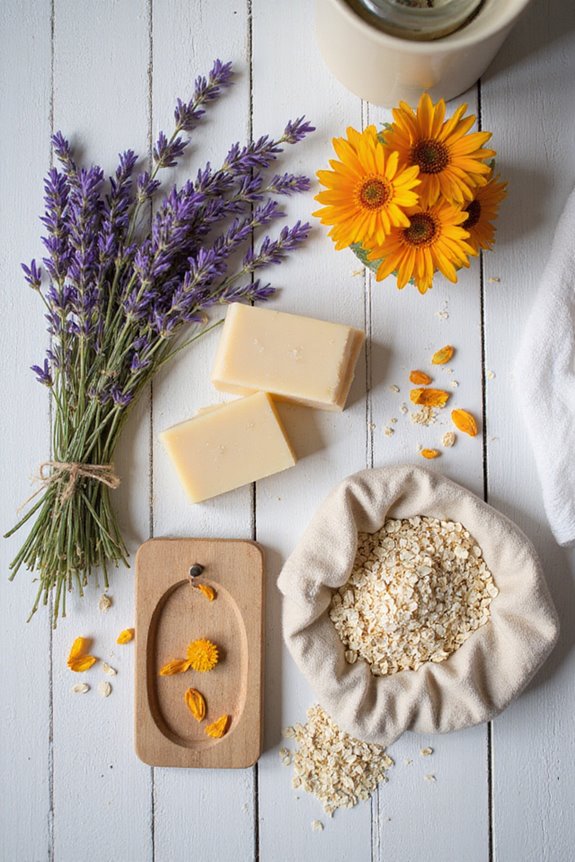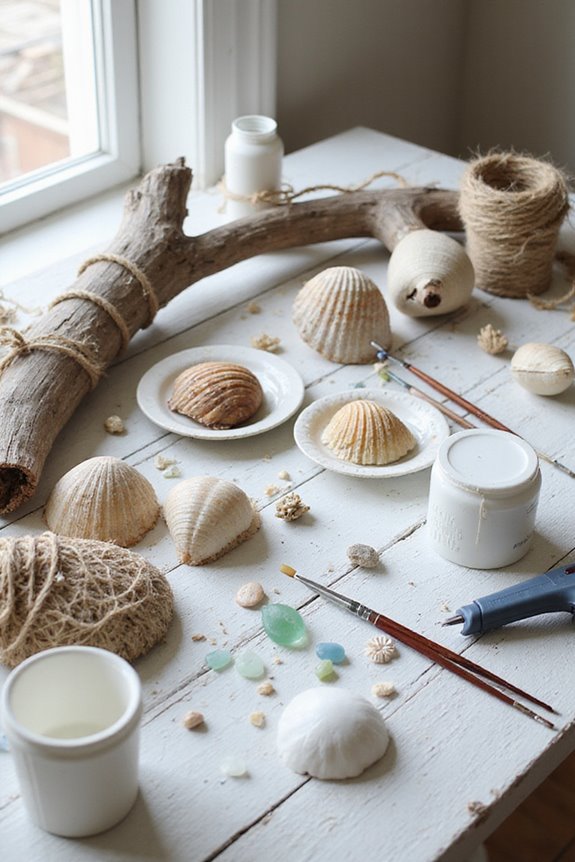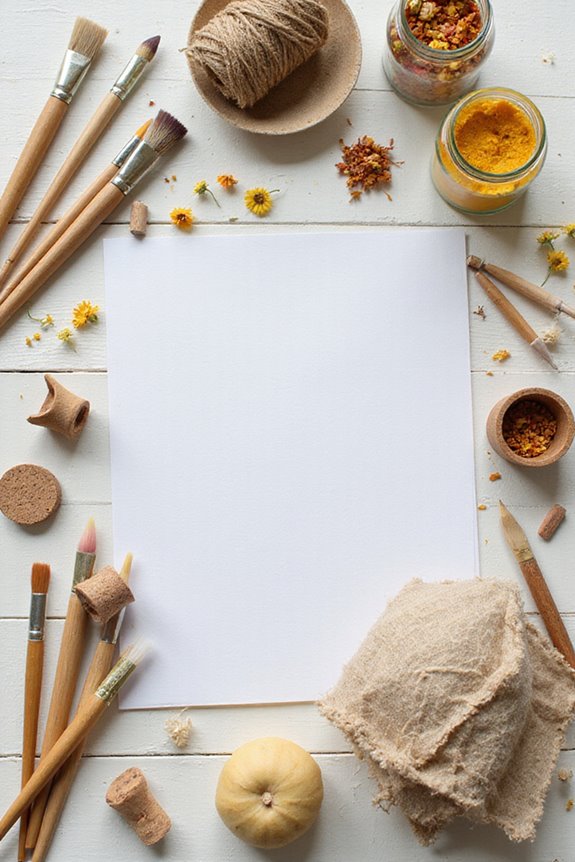Making natural soap with herbs can be fun and rewarding! First, we choose our herbs based on skin needs, like soothing chamomile or acne-fighting yarrow. We can use 1-2 teaspoons of dried herbs per pound of oils. Next, we can infuse oils with herbs or add them during the mixing process for texture. Remember to perform a patch test for safety. Finally, we cure our soap in molds for about 4 to 6 weeks. Let’s craft some beautiful bars together! 🍃✨
Key Takeaways
- Choose herbs based on their skin benefits, like chamomile for soothing and yarrow for acne reduction.
- Infuse oils with herbs by heating them to extract valuable nutrients into the soap.
- Incorporate dried or powdered herbs during the soap-making process for improved texture and color.
- Ensure to research herbs for toxicity and perform patch tests for skin compatibility.
- Cure the soap for 4 to 6 weeks to develop its properties and ensure a quality final product.
Selecting the Right Herbs for Your Soap
When we’re selecting the right herbs for our soap, it’s essential to take into account both their properties and how they’ll impact the final product. 🌿 First, we can look for common herbs with therapeutic benefits that suit our skin’s needs.
For example:
- Chamomile soothes and heals scars.
- Yarrow helps with acne and inflammation.
- Nettle is great for acne-prone skin and can tint our soap green.
We also need to take into consideration scent profiles. Herbs like lavender and peppermint not only add pleasant aromas but also provide calming and invigorating experiences.
As a rule of thumb, we should use about 1-2 teaspoons of dried herbs per pound of oils to maintain balance in our soap. 🧼 Additionally, incorporating essential oils can further enhance the fragrance and skin benefits of your soap.
Methods for Incorporating Herbs Into Soap
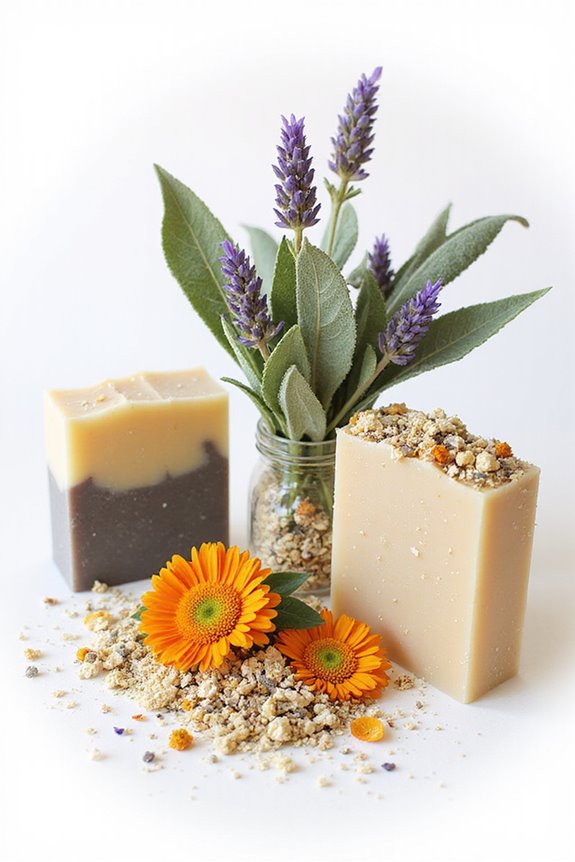
Incorporating herbs into our soap not only enhances its appeal but also infuses it with valuable properties. We can use several infusion techniques, depending on our herb selection.
- Hot or Cold Oil Infusion: Steep herbs like calendula in carrier oils for hours to weeks. This preserves delicate properties and adds nutrients, color, and scent.
- Lye Water Herbal Infusion: Make a concentrated herbal tea to replace plain water in the lye solution. This method captures water-soluble benefits of herbs like chamomile.
- Adding Herbs to Soap Batter: Stir in whole or dried herbs at light trace for texture and visual appeal, but watch for discoloration.
- Using Powdered Herbs: Powdered herbs mix well and provide an even distribution of color and benefits throughout our soap. Additionally, using goat milk soap bases can enhance the moisturizing properties of your herbal soap, providing a luxurious texture and skin benefits.
Benefits of Using Herbs in Natural Soap
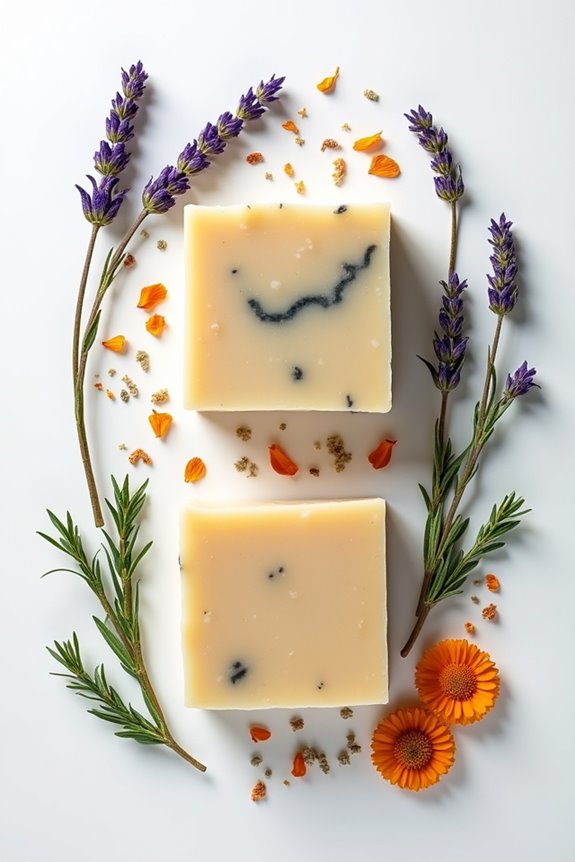
Using herbs in natural soap can truly elevate our soap-making experience, offering a range of benefits we can all appreciate. 🌿 These botanical wonders not only enhance the aesthetics of our soaps but also provide valuable properties for our skin.
Herbs like chamomile and lavender soothe irritation, while green tea and rosemary offer fantastic antioxidant effects, helping us achieve a youthful complexion. Their herbal properties also support healing and regeneration, particularly for those with acne or inflammatory issues. 🤗
Additionally, antibacterial herbs like neem and tea tree are great for keeping our skin clear, reducing breakouts. Plus, using these natural ingredients promotes sustainability, aligning with eco-friendly practices. Embracing herbs in our soaps truly enhances our skin benefits while nurturing the planet. 🌍
Furthermore, incorporating highly pigmented inks can add vibrant colors to your soap creations, enhancing their visual appeal and uniqueness.
Safety and Quality Considerations When Using Herbs
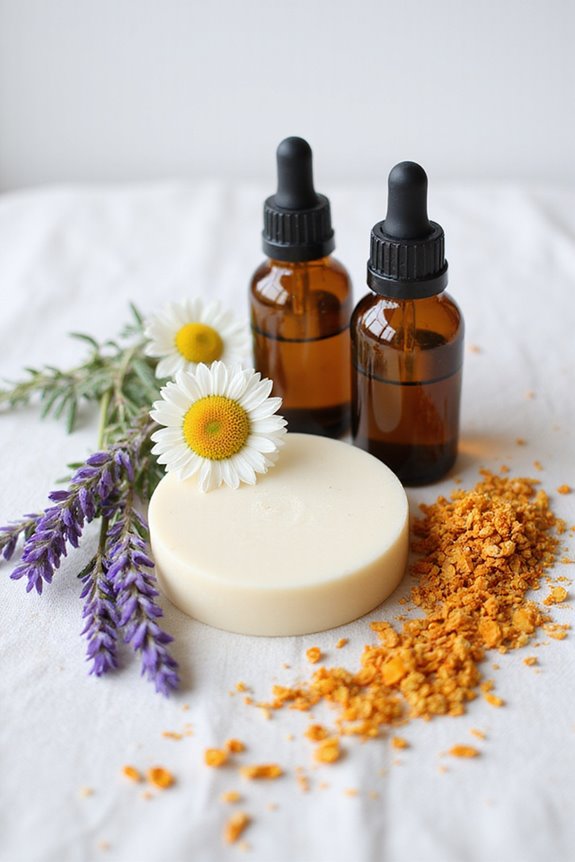
It’s crucial to take into account safety and quality when we incorporate herbs into our natural soap-making process. 🌱 Some herbs can cause skin irritation or even be toxic, so we need to be cautious. Here are a few safety tips:
- Research herb toxicity before use, especially with strong herbs like rue or pennyroyal.
- Conduct patch tests on a small area of skin to detect any reactions.
- Use dried or ground herbs for better integration without spoilage risk.
- Avoid fresh herbs with high moisture content unless processed correctly to prevent microbial growth. Additionally, always consider the safety considerations associated with using various ingredients in crafts to ensure a safe experience.
Step-By-Step Guide to Making Soap With Herbs
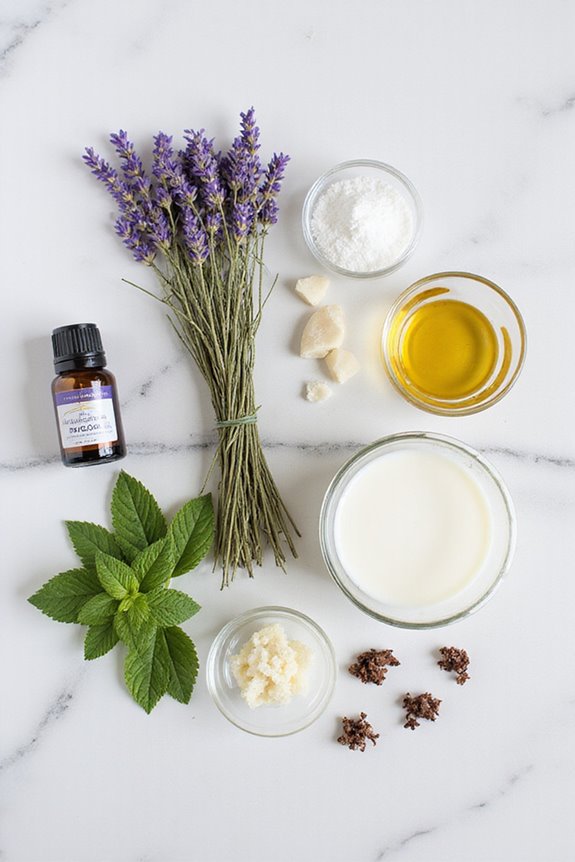
Making soap with herbs can be a fun and rewarding experience that allows us to customize our product with natural scents and skin-benefitting properties. 🌿 To get started, we first need to gather all our ingredients and tools:
- Herb selection: Choose dried or fresh herbs, like lavender or peppermint.
- Essential oils: Have lavender or marjoram ready for added scent.
- Oils: Use coconut, olive, or shea butter for their unique properties.
- Tools: We need a digital scale, immersion blender, silicone molds, and safety gear.
Next, we’ll use infusion techniques by heating oils with herbs to extract their benefits. After mixing our lye solution and oils, we’ll combine everything, reach trace, pour into molds, and cure for 4 to 6 weeks. Incorporating natural ingredients promotes healthier skin and enhances the overall quality of the soap. Happy soap making!
Frequently Asked Questions
How Do I Choose Herbs Based on Skin Type?
When choosing herbs based on our skin type, we should consider herb properties and the specific skin type benefits they provide. This guarantees we select the most effective herbs for our skincare needs and goals.
Can I Use Fresh Herbs Instead of Dried Ones?
Did you know fresh herbs can introduce moisture, leading to spoilage? While they offer vibrant benefits, using dried herbs with proper preservation methods helps guarantee stability and effectiveness in our creations. Let’s choose wisely!
What Essential Oils Pair Well With These Herbs?
When we explore essential oil blends, we find that lavender pairs beautifully with chamomile and rosemary, creating delightful aromatic profiles. Each combination enhances the soothing qualities of the herbs for an elevated sensory experience.
How Long Will the Herbs Retain Their Properties in Soap?
Oh, if only we could bottle the magic of herb potency forever! In reality, with proper soap storage, we can expect herbal properties to last about six months to a year before they start to fade.
Can I Use Herbs for Colored Swirls in Soap?
Absolutely, we can use herbs for colored swirls in soap! By mastering herb infusion techniques and experimenting with color blending methods, we can create stunning and unique swirls that showcase the beauty of natural colorants.

